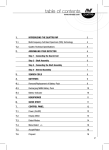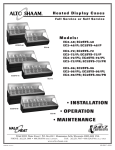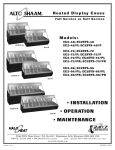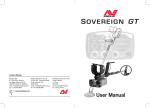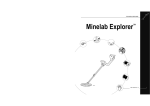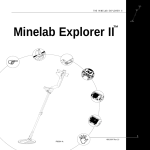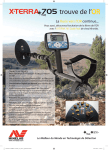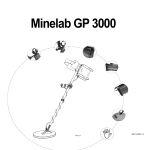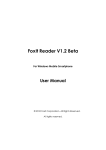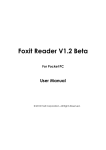Download User Manual - Great Lakes Metal Detecting
Transcript
MINELAB User Manual © 2004 Minelab Electronics Pty Ltd This document contains proprietary information that is protected by copyright. Apart from any use as permitted under the Copyright Act 1968, no part may be reproduced by any process without written permission from Minelab Electronics Pty Ltd, 118 Hayward Avenue, Torrensville, SA 5031, Australia. WARNING. This document contains Minelab Electronics Pty Ltd rights, technical data or restricted rights data, or both. Patents and trademarks apply. Discla ime r The Minelab metal detector discussed in this operating manual has been expressly designed and manufactured as a quality hobbyist metal detector and is recommended for use in coin, treasure and general metal detection in non-hazardous environments. This metal detector has not been designed for use as a mine detector or as a live munitions detection tool. Please read the operating manual prior to using your new detector. Contact Details: Minelab USA 871 Grier Drive, Suite B1 Las V egas, Nevada 89119 UNITED STATES OF AMERICA email: [email protected] tel: +1-702-891 8809 Minelab Electronics Pty Ltd PO Box 537 Torrensville Plaza South Australia 5031 AUSTRALIA email: [email protected] tel: +61-8-8238 0888 Minelab International Limited Laragh, Bandon Co. Cork IRELAND email: [email protected] tel: +353-23 52101 www.minelab.com MINELAB table of contents www.minelab.com 1. INTRODUCING THE QUATTRO MP 3 1.1. Multi-frequency-Full Band Spectrum (FBS) Technology 4 1.2. Quattro Technical Specifications 5 2. ASSEMBLING YOUR DETECTOR 6 Step 1 - Connecting the Search Coil 6 Step 2 - Shaft Assembly 6 Step 3 - Connecting the Shaft Assembly 7 Step 4 - Armrest Assembly 7 3. SEARCH COILS 8 4. BATTERIES 9 4.1. Removal/Replacement of Battery Pack 9 4.3. Recharging NiMH Battery Pack 10 4.4. Battery Indicator 10 5. HEADPHONES 11 6. QUICK START 11 7. CONTROL PANEL 12 7.1. Power (On/Off) 12 7.2. Display Meter 12 7.3. Detect Modes 14 7.4. Menu/Select +/- 16 7.5. Accept/Reject 16 7.6. Pinpoint 16 p1 table of contents www.minelab.com 7.7. Noise Cancel 16 8. MENU SETTINGS 17 8.1. Sensitivity 18 8.2. Volume 18 8.3. Threshold 18 8.4. Noise Cancel 19 8.5. Contrast 19 8.6. Trash Density 19 9. DISCRIMINATION 21 9.1. Modifying Discrimination Scale 21 10. DETECTOR SOUNDS 23 11. USING YOUR QUATTRO MP 23 12. TROUBLESHOOTING 24 13. GLOSSARY OF TERMS 25 14. PRE-SET SETTINGS 26 p2 1. Introducing the Quattro MP www.minelab.com 1. Introducing the Quattro MP Thank you for purchasing the Minelab Quattro MP (multi-purpose) metal detector. The Minelab Quattro MP has been designed with "powerful simplicity" in mind. The Quattro MP has four pre-set detect modes for turn on and go operation, and also features customizable programs which you can save with your own personal settings. The Quattro MP will locate valuable metal objects such as gold, coins, jewelry and other metallic items. The detector’s easy-to-use control panel enables anyone, from beginner to expert, to start detecting immediately after assembling your detector. We recommend you use the NEW Quattro MP in one of the four selectable factory pre-set modes initially to become familiar with its operation. These settings have been optimized to provide you with excellent programs suitable for most applications. Built rugged for years of treasure hunting enjoyment, Minelab stands behind their entire line of metal detectors. To ensure getting the most from the Quattro MP, we recommend that you read this User Manual to help assemble, take care of and learn how to operate your new detector. Minelab Electronics thanks you, and wishes you every success in your treasure hunting. If you have any questions or comments regarding the Minelab Quattro MP or any other Minelab product, please feel free to contact us via your local Authorized Minelab dealer, or write to us: Contact Minelab: Minelab USA 871 Grier Drive, Suite B1 Las Vegas, Nevada 89119 USA email: [email protected] tel: 1-702-891 8809 Minelab Electronics Pty Ltd PO Box 537 Torrensville Plaza South Australia 5031 AUSTRALIA email: [email protected] tel: 61-8-8238 0888 Minelab International Limited Laragh, Bandon Co. Cork IRELAND email: [email protected] tel: 353-23 52101 Please Note: Since there may be a variety of options available for this detector, equipment may vary according to the model or items ordered with your detector. Certain descriptions and illustrations may differ (in this manual) from the exact model that you purchased. In addition, Minelab reserves the right to respond to ongoing technical progress by introducing changes in design, equipment and technical features at any time. p3 1. Introducing the Quattro MP www.minelab.com 1.1. Multi-frequency-Full Band Spectrum (FBS) Technology When developing the Quattro MP, Minelab’s scientists looked at developing a truly easy to use yet extremely powerful multi-purpose metal detector. Discussions with seasoned treasure hunters from around the world identified a number of possible enhancements for operators. Features of the Quattro MP detector include: • Remarkable detection depth • Accurate identification of targets at great depths • Enhanced detection of desired targets among iron "trash" • Enhanced detection capabilities when searching salt-water beaches Most detectors on the market operate on a single (or dual) frequency, ranging up to 70 kilohertz (kHz). Although this technology has served the industry well for years, Minelab’s scientists found that a frequency that worked well in one area would often offer only marginal performance when used in another location. Ground mineralization, trash content, and target size all had an effect on how effective a detector transmitting a single or dual frequency would operate. Full Band Spectrum technology combined with a powerful new microprocessor gives you: 1.1.1. Greater detecting depth • Consistent sensitivity over a wide range of targets • Circuitry that reduces interference from electromagnetic sources • More accurate identification of target characteristics The Full Band Spectrum (FBS) circuit automatically transmits multiple frequencies ranging from 1.5 kHz to 100 kHz simultaneously. This increased frequency range means that the signal received from the detector coil is analyzed from a wide range of responses. This information is relayed to the operator via the speaker or headphones and the control panel’s display as an audio or visual target response. Put simply, Minelab’s unique FBS technology means deeper, more sensitive, and more accurate detecting. 1.1.2. Ground Compensation The Quattro MP uses a sophisticated approach to the elimination of signals caused by ground mineralization. Unlike other forms of ground balancing that require constant readjustment, FBS technology uses advanced digital filtering to eliminate the influence of ground signals. 1.1.3. Operating Frequencies A metal detector’s electromagnetic operating frequencies are measured in kiloHertz (kHz). Low signal frequencies (e.g. 1.5 kHz) penetrate deepest, but sensitivity to smaller targets is low. On the other hand, higher frequencies (e.g. 100 kHz) have a more shallow depth of penetration but high sensitivity to small targets. The Quattro MP’s multiple-frequency operation provides the advantage of both. p4 www.minelab.com 1.2. Quattro MP Technical Specifications Length Unextended 43 inches (1100mm) Length Extended 55 inches (1358mm) Shipping Weight 3 lb 7 oz (1700g) excluding batteries Coil 10.5 inch (264mm) Audio Output Internal speaker or headphones Headphone Input Transmission 1/4 inch (6.3mm) stereo jack Full Band Spectrum. Simultaneous multiple frequency transmission ranging from 1.5kHz –100kHz Ground Rejection Ground compensation – advanced digital filtering Discrimination Linear –10 to +40 discrimination options Visual Display 64 x 128 pixel liquid crystal display (LCD) Detect Modes 4 (Coin; Coin/Jewelry; Relic; All Metal) Pinpoint Yes - Visual and audio Personal Modes 4 programmable/save Automatic Noise Cancel (Scanning) Yes Trash Density Settings 2 (High/Low) Target Depth Meter Yes (0-12 or more inches) Battery Meter Batteries Yes (with audible low battery warning) 1600 or 1800 mAh NiMH rechargeable battery pack (Varies by country/region) or 12V Alkaline pack. (Cells not included). Patents US 4890064, US 5537041, US 5506506 Optional Accessories Alkaline or NiMH battery pack Mains charger Car charger Control Box Cover Coil Cover Carry Bag 8 inch (200mm) "Double D" waterproof Coil p5 2. assembling your detector www.minelab.com 2. Assembling Your Detector To assemble your Minelab Quattro MP, follow steps 1 to 4 below. Step 1 - Connecting the Search Coil To attach the search coil to the lower shaft: 1. Plug the two rubber washers (1) into the holes on either side of the coil yoke (2). 2. Place the search coil (3) on a flat surface with the front of the coil facing away from you, and check that the open side of the yoke is facing the ground. 3. Slide the yoke into the yoke bracket on top of the coil. 4. Insert plastic bolt (4) through the search coil’s yoke bracket and the coil yoke. Fasten with the yoke nut (5) provided, being careful not to damage the thread of the nut by over-tightening. This may need to be loosened to adjust the coil to a comfortable detecting angle. Caution: DO NOT attempt to disconnect the coil cable where it enters the search coil itself as this cable is direct wired into the coil and is not dismountable. Any attempt to disconnect this cable will void your coil warranty. Step 2 - Shaft Assembly 1. Release the shaft camlock lever (6) before inserting the lower shaft (7). 2. Feed the coil cable (8), which is inside the lower shaft all the way through the inside of the upper shaft (9). Make sure the longer side of the bevelled shaft (10) is at the back of the control box. Note: When exchanging the standard coil with an accessory coil like the 8", it may be easier to pull the cable through the lower shaft using a length of string or cord. Once this is completed you should be able to see approximately 4 inches (100mm) of cable between the coil yoke and the search coil. This is the slack necessary to allow adjustment to the angle of the search coil. 3. Slide the lower shaft entirely into the upper shaft until the camlock rests against the yoke. 4. Pull the coil cable’s metal connector (11) through the open end of the upper shaft until it ‘dangles’ from the opening. p6 www.minelab.com Step 3 - Connecting the Shaft Assembly To connect the shaft assembly to the handle assembly: 5. Release the control box camlock lever (12) to the open position. 6. Push the coil cable connector into the socket (13) underneath the handle assembly control box. Ensure the connector’s threaded bracelet is firmly secured. 7. Extend the lower shaft from the upper shaft by approximately 6 inches (15cm) to prevent the coil cable ‘bunching’. 8. Push the upper shaft firmly into the control box until you feel it has reached the back of the control box, making sure that the control box camlock lever is in the released position. 9. Secure the upper shaft in position by locking the control box camlock (12). 10. Adjust the shaft to the desired length for your height and then lock with shaft camlock lever (6). 11. Tilt the search coil to the most comfortable angle, keeping in mind it will need to be parallel to the ground during detecting. Note: To avoid difficulty securing the control box camlock lever (step 9), ensure the shaft camlock is released to allow greater shaft movement. Step 4 - Armrest Assembly To adjust the armrest assembly: 12. Loosen the screw (i) in the center of the armrest (turning counter-clockwise). 13. Place your arm into position and slide the armrest back (ii) so that it is comfortable under your elbow. 14. Tighten screw (clockwise) to lock into position. 2.1.1. Fitting the armrest strap 15. Thread the strap through the buckle openings (iii). 16. Clip both buckles into the openings at each outer side of the armrest. 17. Test by sliding your arm underneath the strap and resting your forearm on the armrest. 18. Loosen strap by tilting the edge of the buckle out to release it from the armrest. Undo the Velcro and pull the buckle outwards (towards yourself.) Clip the buckle back into place and tighten the strap by pulling up. The next time you use your detector, all you will need to do is click the buckle back into the armrest. p7 3. search coils www.minelab.com 3. Search Coils The function of the search coil is to transmit electromagnetic signals into the ground, and receive the response. The Quattro MP is supplied with a 10.5 inch open web "Double D" search coil. Double D is the common term used to describe the two internal coil windings which overlap each other, producing a blade like search pattern. The advantages of Double D coils are very good ground cancelling abilities, and very good ground coverage, as the coil has an even detection range along its entire length. Because of this, the operator is only required to slightly overlap each sweep, to ensure all targets at maximum depth are recovered. The 10.5" coil is excellent for general searching. There is an optional 8" coil available that provides greater sensitivity to small targets, and improved performance in high trash areas. Both coils are epoxy filled, so they can be submersed in water, but care must be taken to ensure the control box remains dry. To replace the search coil: 1. Undo control box camlock and disconnect the coil cable from the control box. 2. Separate the two shaft assemblies by releasing the shaft camlock and sliding the lower shaft out. 3. Loosen the plastic nut and remove the bolt from the yoke bracket. 4. Gently pull the coil cable from inside the yoke/lower shaft. 5. Carefully feed the new coil cable into the yoke and lower shaft. Continue to feed the cable into the shaft until the connector is visible at the top of the shaft. Note: It may be easier to pull the cable through the lower shaft using a length of string or cord. Once this is completed you should be able to see approximately 4 inches (100mm) of cable between the coil yoke and the search coil. This is the slack necessary to allow adjustment to the angle of the search coil. 6. Re-attach the yoke and the search coil. 7. Reconnect cable to control box (as directed in Connecting the shaft assembly, page 7). Caution: DO NOT attempt to remove the coil cable from the search coil. Any attempt to disconnect will void your coil warranty. Note: For ease of changing colis, it is advised that each coil be fitted to its own lower shaft. p8 4. batteries www.minelab.com 4. Batteries The Minelab Quattro MP has both Alkaline and NiMH battery packs available as either standard or accessory items. The NiMH 1600 mAh battery pack will power the detector for up to 12.5 hours of constant use and the NiMH 1800 mAh battery pack for 14 hours. Eight good quality, fresh, 1.5V AA alkaline batteries will power the Quattro MP for up to 14 hours of constant use. Unlike Nickel Cadmium batteries, the NiMH battery pack DOES NOT have to be discharged before recharging. Whenever the detector has been unused for a lengthy period, recharge the battery pack to ensure full performance. There is no limit to the time the battery pack can be left on charge. Removal instructions apply to both types of battery packs. 4.1. Removal/Replacement of Battery Pack To Remove the Battery Pack: 1. Turn Detector off. 2. Lift the rubber cap of the battery handle assembly. 3. Raise the yellow tab. This releases the spring-loaded battery pack. 4. Remove battery pack from handle assembly. To Replace the Battery Pack, slide the pack into the compartment until it ‘clicks’ into place. 4.2. Inserting Alkaline Batteries 1. Slide back the sliding door of the alkaline battery pack in the direction of the arrow. 2. Install 8 good quality fresh AA alkaline batteries in the direction of the arrows located inside the battery pack 3. Close the sliding battery door and re-install into battery handle compartment. p9 4. batteries www.minelab.com 4.3. Charging the NiMH Battery Pack To charge your battery, only use the Minelab charger designed for your NiMH battery. Using other chargers may damage your battery and will void the product warranty. Wall/Mains Charger The NiMH battery pack is sold in the discharged condition. It is necessary to charge it before operating the detector. 1. Plug the mains charger into the wall socket. 2. Insert the mains charger plug into the socket at the tapered end of the battery pack. Leave for about 18 hours to fully charge. 3. Remove the battery charger plug from the battery pack, ready for use. Note: You may find that the first couple of times you charge your battery, you may not achieve the full hours of operation. The batteries will reach their full capacity after several recharge cycles. Car Charger 4. Insert the car charger plug into the cigarette lighter socket of your vehicle. 5. Insert the car charger plug into the socket at the tapered end of the battery pack. A small light on the car charger illuminates indicating that the car charger is in operation. 6. Leave the battery to charge for about 18 hours for a complete charge. If the battery was not completely discharged, the charging time will be shorter. The car charger is provided with a 3AG 2Amp fast fuse for short circuit protection, which can be accessed by unscrewing the tip of the cigarette lighter plug. Note: Charging the battery beyond full capacity will not damage the NiMH battery pack, but it could gradually discharge your car battery. Safety Tip: Do not attempt to disassemble the NiMH battery pack. If disposing of pack, do not incinerate. Contact your local authorities to enquire about disposal or recycling facilities. 4.4. Battery Indicator A battery indicator is displayed on the Quattro MP detect screen. The battery will be fully shaded at maximum battery charge. When this shaded area decreases to the left hand side, the detector will begin to emit a low battery warning sound. When this low battery warning is heard, there will be only a few minutes of life left in the batteries. It is recommended that the batteries be replaced or recharged as soon as possible to avoid missing any targets. When the battery symbol is completely un-shaded and flashing, the detector will sound an alarm before displaying the message ‘FLAT BATTERY SHUTDOWN’ and turning itself off. To start detecting again, remove the battery and replace with a fully charged battery. p10 5. headphones www.minelab.com 5. Headphones The use of headphones while treasure hunting can reduce the distraction of external noise and allow the operator to hear softer target signals. While the use of headphones is not necessary during operation, the reduced power demands of the headphones will extend battery life. The 1/4" socket for the headphone plug is located in the top right of the rubber seal at the top of the handle assembly. The headphones may be plugged into this socket or unplugged at any stage of operation. We would recommend a comfortable feeling headphone with a high (32+) ohm rating. Minelab’s Custom Koss headphones available as an accessory are rated at 100 ohm. 6. quick start 6. Quick Start • Simply turn on the Quattro MP by pressing the POWER button. • On the initial start-up, your detector will default to the factory COIN mode. • To select a different factory pre-set Detect mode, press and release the appropriate mode button. • The icon next to the corresponding preset mode, indicates that a factory preset mode has been selected. The detector will apply the factory determined discrimination pattern, and audio response for that mode. • Press the NOISE CANCEL button and wait the 20 seconds it takes to select the most stable channel. • Once the sound sequence is completed, you can start detecting! p11 7. control panel www.minelab.com 7. Control Panel 1. Power (On/Off) 2. Display Meter 3. Detect Modes a. Coin Mode b. Coin & Jewelry Mode c. Relic Mode d. All Metal Mode 4. Menu/Select 5. -/+ (Minus / Plus) 6. Accept/Reject 7. Pinpoint 8. Noise Cancel 7.1. Power (On/Off) Press and release the POWER button (1) to turn your detector on/off. On first time start-up, your detector will default to the COIN mode and you can begin detecting. When you turn your detector on following your first time use, the detector will start with the previous setting, from when the detector was last used. To start the detector in the ‘Factory Preset’ mode, (recommended in your first few outings) press and hold the POWER button (approximately 5 seconds), until the Factory Preset message is displayed on the screen.. 7.2. Display Meter A. Battery Power Icon B. Graphic Identification Bar C. Discrimination Pattern D. Target Cursor E. Target ID Number F. Target Icons G. Depth Gauge H. Mode Indicator p12 7. control panel www.minelab.com 7.2.1. Battery Power icon At the top right-hand corner of the screen is an icon of a battery (A). This shows the level of stored power in your battery. A fully charged battery shows the icon as fully shaded. As the power in the battery is used the shaded area depletes until a fully discharged battery is un-shaded. 7.2.2. Graphic Identification Bar Located across the base of the screen is a horizontal bar graph (B) and serves a number of purposes. It shows the operator the discrimination pattern (C), which has been set. > Dark bars (C) show the areas of rejection. This means certain unwanted target types will be rejected (or ignored) by the detector. > The Light bars show areas of acceptance. This means the detector will recognize and signal the user, when certain desirable targets are found. > When a target is detected, a triangular cursor (D) will flash three times above a hollow bar, the location of which corresponds to the ID number (E) (see below) shown in the meter. 7.2.3. ID Number When a target is detected while searching, a number (E) appears on the left side of the meter identifying the characteristics of the target. ID numbers range from -10 through to +40 and are the detectors numerical identification of the type of target that has been located. Different target types will bring up different numbers. Tip: You can practice getting familiar with your Quattro MP by selecting different coins and jewelry and passing each one over the coil a number of times and noting the different numbers each type will produce. Note: These same ID numbers can be used by the operator to make alterations to the discrimination pattern (see 9.1.2) and will also be useful in recognizing common targets. 7.2.4. Target Icons Similar to the ID numbers, the Quattro MP will also indicate the likely target type located, using a select number of generic icons (F). At times the meter may display two icons at once, indicating that the characteristics of the target located is similar to that of a number of targets. Note: Target icons only appear in the COIN and COIN/JEWELRY modes. p13 7. control panel www.minelab.com 7.2.5. Depth Reading Located in the center of the meter is a vertical bar (G), which predicts the likely depth of the target. On shallow targets, the cursor is very high or close to the top, and the bar becomes almost fully shaded, whereas for deep targets the cursor is quite close to the bottom, and the bar is only partially filled. The full depth of the bar is equal to 12" plus, meaning that the target will be greater than 12" deep. If the bar is only half shaded, the depth of the target is likely to be about 6" deep. Information on the target’s depth is very useful if detecting in sensitive areas like sports grounds or parks. By using the depth meter you can concentrate on a specific depth of the soil, which can improve your success rate. 7.2.6. Overload If the target is too big or too close to the coil to be classified, the word OVERLOAD will appear on the display screen. This is accompanied by a rapid continuous buzzing sound. Detect the target again by lifting the coil slightly higher and you will often get an accurate response. 7.3. Detect Modes There are four factory pre-set ‘Detect’ modes and four save modes available for searching. Each mode is customized with the optimum settings, to allow you to find the types of objects described by the detect mode name. The four detect modes are: - Coin (3a) - Coin/Jewelry (3b) - Relic (3c) - All Metal (3d) In some locations, there may be a specific pattern to the type of targets found in the area. For example, an old house or building site may have certain areas where a certain junk type has been concentrated, or other areas where it is more likely coins have been lost. On the beach, foil and modern coins are more plentiful on the dry sand, whereas less junk and more gold jewelry are located on the wet sand. Due to the different types of targets you may expect in certain areas, you will often prefer a different discrimination pattern for each area. With the Minelab Quattro MP, you have the choice to search in one of the factory pre-set discrimination patterns, or you can create and save your own patterns to suit the different areas you commonly search. Start – Up On the initial start-up, your detector will default to the factory COIN Mode. To select a different factory pre-set Detect mode, press and release the appropriate mode button. The icon (H) next to the corresponding preset mode, indicates that a factory preset mode has been selected. The detector will apply the factory determined discrimination pattern, and audio response for that mode. QUICK START: Simply turn on the Quattro MP by pressing the POWER button (1), select one of the four preset modes (3a; b; c;or d), press the NOISE CANCEL (8) and you can commence detecting straight away. p14

















